#University of Arizona Museum of Art
Explore tagged Tumblr posts
Text
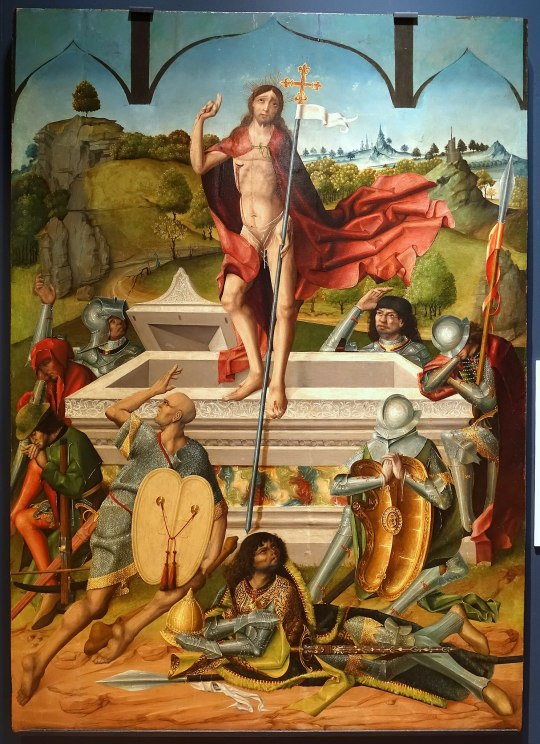
The Resurrection (from the Ciudad Rodrigo altarpiece), Maestro Bartolomé and workshop, between 1480 and 1488
#Easter#Easter Sunday#Resurrection#art#art history#Maestro Bartolomé#religious art#Biblical art#Christian art#Christianity#Catholicism#New Testament#Gospels#Spanish art#15th century art#oil on panel#University of Arizona Museum of Art
105 notes
·
View notes
Photo
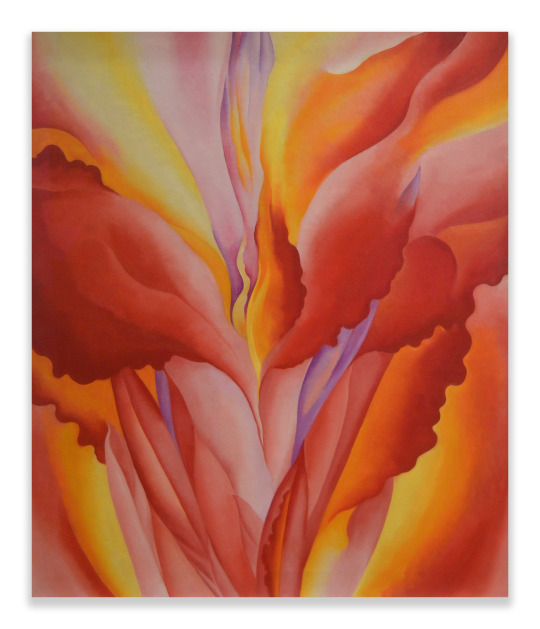
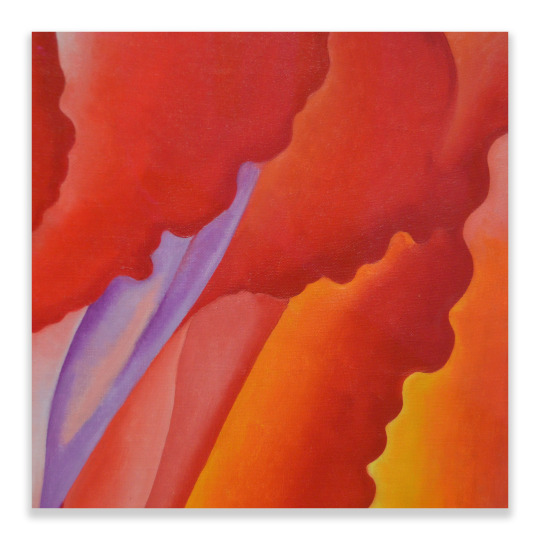
Georgia O’Keeffe / Red Canna, 1925 - 1928 / Oil on canvas mounted on Masonite.
On view at Abstract Perspectives in Mid-century Art at the University of Arizona Museum of Art in Tucson.
I love the fiery colors and the macro perspective in this painting. O’Keeffe said of her flower paintings, "When you take a flower in your hand and really look at it, it's your world for the moment. I want to give that world to someone else.”
#photographers on tumblr#Georgia O'Keeffe#mid-century abstract art#women artists#University of Arizona Museum of Art#Tucson#Arizona
152 notes
·
View notes
Text
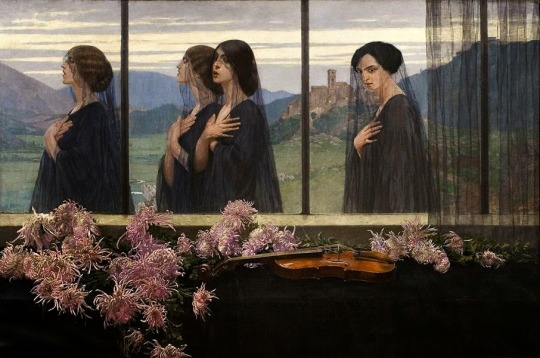
Edward Okuń (1872-1945) "The Four Strings of a Violin" (1914) Located in the Arizona State University Art Museum, Tempe, Arizona, United States
#paintings#art#artwork#painting#funeral#edward okuń#edward okun#fine art#museum#art gallery#polish artist#musical instruments#instrument#pink flowers#clothing#clothes#black dress#dresses#side profile#female portrait#portrait of a woman#veil#1910s#early 1900s#early 20th century#a queue work of art#1k#2k
3K notes
·
View notes
Text

Winter Solstice 2024
It is cold and it is dark, but the Winter Solstice brings the promise of light's return and the warming of our world. To celebrate this most important day, we feature a naturally-dyed wool weaving entitled Náhookǫsji Hai (Winter in the North) / Biboon Giiwedinong (It is Winter in the North) held at the Minneapolis Institute of Art (MIA) and produced by Navajo artist D. Y. Begay in 2018. This image, which is only a portion of the slightly larger work, is from our copy of the exhibition catalog Hearts of Our People: Native Women Artists edited by Jill Ahlberg Yohe and Teri Greeves (Kiowa) and published by the MIA in association with the University of Washington Press in 2019.
D.Y. Begay (b. 1953), a Navajo born to the Totsohni’ (Big Water) Clan and born for the Tachinii’ (Red Running into Earth) Clan, is a fourth-generation weaver. Begay’s tapestries encompass her interpretation of the natural beauty and descriptive colors of the Navajo reservation, reflecting on her Navajo identity and her family’s weaving tradition. This spiritual connection to the plants yields the natural colors that are transformed into evocative land formations on her loom. Of the weaving shown here, Jennifer McLerran, curator at the Museum of Northern Arizona and a retired assistant professor of art history at Northern Arizona University, writes:
Most of D. Y. Begay's textiles respond to the Southwest landscape in which she was raised and resides today. For this work, a textile produced with all-natural dyes and handspun wool, Begay traveled to Minnesota in the depths of winter to observe the land surrounding the Grand Portage Indian Reservation of the Ojibwe people. Over an extended period she observed changing light conditions as the sun and clouds moved across the sky, altering the hues of snow and water.

D. Y. Begay with her weaving Confluence of Lavender by Arizona videographer Kelso Meyer, 2016. From the University of Virginia Mellon Indigenous Arts Program.
We wish you a most serene Winter Solstice.
View posts from Winter Solstices past.
View other posts from our Native American Literature Collection.
#Winter Solstice#D. Y. Begay#Winter in the North#Navajo weaving#Navajo textiles#Indigenous artists#Navajo#Ojibwe#textiles#Native American artists#Native Americans#Indigenous#indigeneity#Jill Ahlberg Yohe#Teri Greeves#Jennifer McLerran#Hearts of Our People: Native Women Artists#Native American Literature Collection#Indigenous American Literature Collection#Native American art#Indigenous art
267 notes
·
View notes
Text







The first major solo museum presentation of fourth-generation Navajo weaver Melissa Cody (b. 1983, No Water Mesa, Arizona) spans the last decade of her practice, showcasing over 30 weavings and a major new work produced for the exhibition. Using long-established weaving techniques and incorporating new digital technologies, Cody assembles and reimagines popular patterns into sophisticated geometric overlays, incorporating atypical dyes and fibers. Her tapestries carry forward the methods of Navajo Germantown weaving, which developed out of the wool and blankets that were made in Germantown, Pennsylvania and supplied by the US government to the Navajo people during the forced expulsion from their territories in the mid-1800s. During this period, the rationed blankets were taken apart and the yarn was used to make new textiles, a practice of reclamation which became the source of the movement. While acknowledging this history and working on a traditional Navajo loom, Cody’s masterful works exercise experimental palettes and patterns that animate through reinvention, reframing traditions as cycles of evolution. Melissa Cody is a Navajo/Diné textile artist and enrolled member of the Navajo/Diné nation. Cody grew up on a Navajo Reservation in Leupp, Arizona and received a Bachelor’s degree in Studio Arts and Museum Studies from Institute of American Indian Arts, Santa Fe. Her work has been featured in The Barnes Foundation, Philadelphia (2022); Crystal Bridges Museum of American Art, Bentonville, AR (2021); National Gallery of Canada, Ottawa (2019–2020); Museum of Northern Arizona, Flagstaff (2019); SITE Santa Fe (2018–19); Ingham Chapman Gallery, University of New Mexico, Albuquerque (2018); Navajo Nation Museum, Window Rock (2018); and the Museum of Contemporary Native Arts, Institute of American Indian Arts, Santa Fe (2017–18). Cody’s works are in the collections of the Stark Museum of Art, Orange, Texas; the Minneapolis Institute of Arts; and The Autry National Center, Los Angeles. In 2020, she earned the Brandford/Elliott Award for Excellence in Fiber Art.
Melissa Cody: Webbed Skies currently on exhibition at MoMA PS1 through September 9nth, 2024
IDs Under the cut
Top to Bottom, Left to Right: White Out. 2012. 3-ply aniline dyed wool. 17 × 24″ (43.2 × 61 cm)
Deep Brain Stimulation. 2011. Wool warp, weft, selvedge cords, and aniline dyes. 40 x 30 3/4 in. (101.6 x 78.1 cm)
World Traveler. 2014. Wool warp, weft, selvedge cords, and aniline dyes. 90 x 48 7/8 in. (228.6 x 124.1 cm)
Into the Depths, She Rappels. 2023. Wool warp, weft, selvedge cords, and aniline dyes. 87 x 51 9/16 in. (221 x 131 cm)
Lightning Storm. 2012. 3-ply aniline dyed wool. 14 × 20″ (35.6 × 50.8 cm)
Pocketful of Rainbows. 2019. Wool warp, weft, selvedge cords, and aniline dyes. 19 x 10 3/4 in. (48.3 x 27.3 cm)
Path of the Snake. 2013. 3-ply aniline dyed wool. 36 × 24″ (91.4 × 61 cm)
74 notes
·
View notes
Text
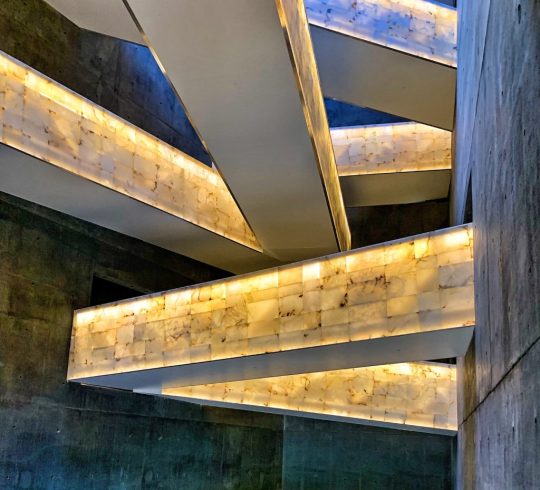


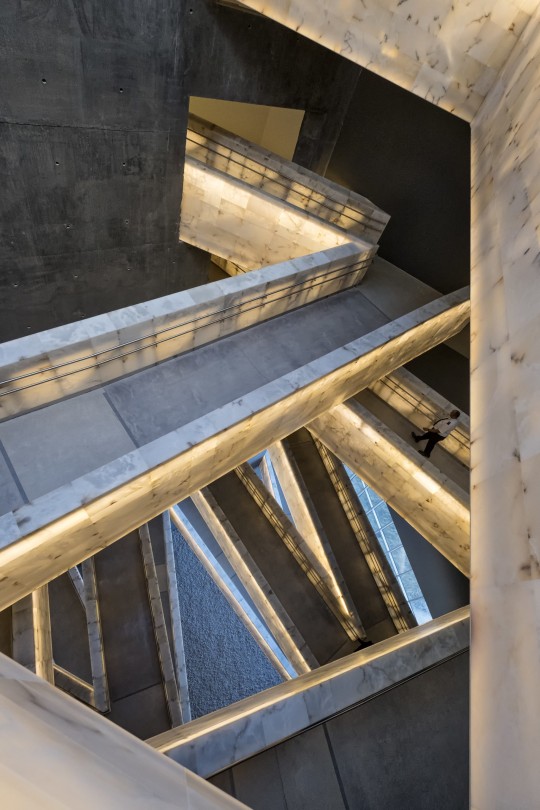
Antoine Samuel Predock, FAIA (June 24, 1936 – March 2, 2024)
Mr Predock was an American architect based in Albuquerque, New Mexico. He was the principal of Antoine Predock Architect PC, the studio he founded in 1967.
Mr Predock first gained national attention with the La Luz community in Albuquerque, New Mexico. The first national design competition he won was held by the Nelson Fine Arts Center at Arizona State University.
Mr Predock's work includes the Turtle Creek House, built in 1993 for bird enthusiasts along a prehistoric trail in Texas, the Tang Teaching Museum and Art Gallery at Skidmore College, and a new ballpark for the San Diego Padres, the Petco Park. He also worked on international sites such as the National Palace Museum Southern Branch in Southern Taiwan and the Canadian Museum for Human Rights in Winnipeg, Manitoba.
Canadian Museum for Human Rights, Winnipeg, Manitoba.
#art#design#stairwell#architecture#stairway#staircase#stairs#interiors#staircases#new mexico#canada#antoine predock#rip#rip antoine predock#winnipeg#manitoba#hunman rights#la luz#FAIA
106 notes
·
View notes
Note
anytime i see a rothko on here not posted by you i’m like “let’s not be so sure”
immediately dubious
Haha, that's funny! But you know. honestly, when I started this account I had no idea how many fakes, Photoshop's and misattributions there were and I adopted the same "Let's not be so sure" attitude and it caused me to be more critical about what I was seeing.
I hate making mistakes here because I want to help sort it out for people and sometimes I either just don't know or I get the wrong information. You'd be surprised how many books have scans that are upside down or mislabeled, I guess it happens to everyone. I will always correct a mistake here if I know about it.
Now I have better sources than I used to and it's a little easier for me to be definitive about a painting but the fact remains that some of these paintings were photographed once and disappeared into a private collection or never photographed at all. I used to pore over inferior scans looking at brushstroke differences, especially on the dark paintings trying to determine things if two paintings matched and followers here kindly indulged my ramblings about it.
Many of the more subtle problems in identifying the best Rothko works are inherent in the art itself. There are huge Blue/Green shifts in Rothko works depending on museum conditions. On some paintings, they looked green dominant and then the catalog raisonne came out and the new scans were blue dominant and now in newer photographs they have shifted back (partially) to green, and this because the warmth or coolness of museum lighting affecting the way paintings are photographed. This was tested well at the University of Arizona where they have a blue and green Rothko and could chart how one color or the other was appearing depending on their led lighting.
What's going on now I think is good. We're experiencing an uptick scan quality and in instituions redoing their pictures and engaging in forensic work on the art. I'm grateful for better scans, I think it makes the art more engaging for people.
So forgive me for rambling about this, but it's nice to see people out there being critical and I do get a lot of questions privately about this sort of thing and anyone is welcome to send me those if they like.
One of the great things for the understand of this work has been the contributions that all of you make. Seeing the museum shots people send in provides new looks at the paintings that really enhance our collective understanding.
#mark rothko#markrothko#rothko#daily rothko#dailyrothko#abstract expressionism#modern art#abstraction#colorfield#ab ex#colorfield painting#mid century#anonymous#questions
89 notes
·
View notes
Text
Online History Short-Courses offered by Universities Masterpost
Categories: Classical Studies, Egyptology, Medieval, Renaissance, The Americas, Asia, Other, Linguistics, Archaeology
How to get Coursera courses for free: There are several types of courses on Coursera, some will allow you to study the full course and only charge for the optional-certificate, for others you will need to audit it and you may have limited access (usually just to assignments), and thirdly some courses charge a monthly subscription in this case a 7 day free trial is available.
Classical Studies 🏛️🏺
At the Origins of the Mediterranean Civilization: Archeology of the City from the Levant to the West 3rd-1st millennium BC - Sapienza University of Rome
Greek and Roman Mythology - University of Pennsylvania
Health and Wellbeing in the Ancient World - Open University
Roman Architecture - Yale
Roman Art and Archeology - University of Arizona
Rome: A Virtual Tour of the Ancient City - University of Reading
The Ancient Greeks - Wesleyan University
The Changing Landscape of Ancient Rome. Archeology and History of Palatine Hill - Sapienza University of Rome
Uncovering Roman Britain in Old Museum Collections - University of Reading
Egyptology 𓂀⚱️
Egypt before and after pharaohs - Sapienza University of Rome
Introduction to Ancient Egypt and Its Civilization - University of Pennsylvania
Wonders of Ancient Egypt - University of Pennsylvania
Medieval 🗡️🏰
Age of Cathedrals - Yale
Coexistence in Medieval Spain: Jews, Christians, and Muslims - University of Colorado
Deciphering Secrets: The Illuminated Manuscripts of Medieval Europe - University of Colorado
Enlightening the Dark Ages: Early Medieval Archaeology in Italy - University of Padova
Lancaster Castle and Northern English History: The View from the Stronghold - Lancaster University
Magic in the Middle Ages - University of Barcelona
Old Norse Mythology in the Sources - University of Colorado Bolder
Preserving Norwegian Stave Churches - Norwegian University of Science and Technology
The Book of Kells: Exploring an Irish Medieval Masterpiece - Trinity College Dublin
The Cosmopolitan Medival Arabic World - University of Leiden
Renaissance ⚜️🃏
Black Tudors: The Untold Story
European Empires: An Introduction, 1400–1522 - University of Newcastle
The Mediterranean, a Space of Exchange (from Renaissance to Enlightenment) - University of Barcelona
The Life and Afterlife of Mary Queen of Scots - University of Glasgow
The Tudors - University of Roehampton London
The Americas 🪶🦙🛖
History of Slavery in the British Caribbean - University of Glasgow
Indigeneity as a Global Concept - University of Newcastle
Indigenous Canada - University of Alberta
Indigenous Religions & Ecology - Yale
Asia 🏯🛕
Contemporary India - University of Melbourne
Introduction to Korean Philosophy - Sung Kyun Kwan University
Japanese Culture Through Rare Books - University of Keio
Sino-Japanese Interactions Through Rare Books - University of Keio
The History and Culture of Chinese Silk - University for the Creative Arts
Travelling Books: History in Europe and Japan - University of Keio
Other
A Global History of Sex and Gender: Bodies and Power in the Modern World - University of Glasgow
A History of Royal Fashion - University of Glasgow
Anarchy in the UK: A History of Punk from 1976-78 - University of Reading
Biodiversity, Guardianship, and the Natural History of New Zealand: A Museum Perspective - Te Papa
Empire: the Controversies of British Imperialism - University of Exeter
Great South Land: Introducing Australian History - University of Newcastle
Indigeneity as a Global Concept - University of Newcastle
New Zealand History, Culture and Conflict: A Museum Perspective - Te Papa
Organising an Empire: The Assyrian Way - LMU Munich
Plagues, Witches, and War: The Worlds of Historical Fiction - University of Virginia
Russian History: from Lenin to Putin - University of California Santa Cruz
Linguistics 🗣️
Introduction to Comparative Indo-European Linguistics - University of Leiden - Coursera version
Miracles of Human Language: An Introduction to Linguistics - University of Leiden
Archeology 💀
Archeoastronomy - University of Milan
Archaeology and the Battle of Dunbar 1650 - Durham University
Archaeology: from Dig to Lab and Beyond - University of Reading
Archeology: Recovering the Humankind's Past and Saving the Universal Heritage - Sapienza University of Rome
Change of Era: The Origins of Christian Culture through the Lens of Archaeology - University of Padova
Endangered Archaeology: Using Remote Sensing to Protect Cultural Heritage - Universities of Durham, Leicester & Oxford
Enlightening the Dark Ages: Early Medieval Archaeology in Italy - University of Padova
Exploring Stone Age Archaeology: The Mysteries of Star Carr - University of York
Forensic Archaeology and Anthropology - Durham University
Roman Art and Archeology - University of Arizona
The Changing Landscape of Ancient Rome. Archeology and History of Palatine Hill - Sapienza University of Rome
#side note: most of the universities that offer courses in English on these sites are European or American(USA)#so the lack of courses about Asia (other than Japan) The Americas and Africa is not because of me#history#historical#classical studies#ancient Greece#ancient Rome#pompeii#Egyptology#pharaoh#ancient Egypt#medieval#medieval europe#Medieval Arabia#Renaissance#Tudor#the tudors#history courses#courses#linguistics#archeology#archeology courses#resources#free resources
179 notes
·
View notes
Text


1480-1488 Fernando Gallego - The Circumcision
(University of Arizona Museum of Art)
62 notes
·
View notes
Text

Otto Hagel
New York, Museum of Modern Art Backyard
1938
Gelatin silver print
Overall, Primary Support: 10 1/2 x 13 3/8 in. (26.7 x 34 cm); Image: 10 1/2 x 13 3/8 in. (26.7 x 34 cm)
Center for Creative Photography, University of Arizona
Hansel Mieth/Otto Hagel Archive
14 notes
·
View notes
Text








♥ June 18- Lecture, Museum, and Meander!
We started today with breakfast and a longer lecture. This lecture was extremely interesting, covering deception in media and how we view information given by sources. This was a very interactive lecture, her purpose of it was almost experimental. She wanted to see how we reacted to the information and those with opposing opinions. It was really enjoyable.
After that we had some time to eat at the cafe in the arts centre. I had a Mediterranean pasta with some potatoes and hummus.
After lunch, we rode the bus to the Museum that was downtown. Aberystwyth is a quaint town, the beach and downtown both easily walkable from the University. The Museum was so interesting, it contained dioramas of different snippets of time, such as an old chemistry shelf or a milk wagon. There were 3 floors just packed with information. We had a lovely woman give us a bit of a rundown and teach us some words in welsch. Bore da!
After the museum, our N.A.D.G.P group from the free day, plus Jordan ate at a cute cafe and checked out some vintage shops nearby. We also checked out a tarot themed restaurant that was beautiful, and one of the staff was from Arizona! She was a sweetheart.
We spent the rest of our night at an arcade on the seashore, even venturing onto the dock where the cold wind from the sea kept whipping us around. We also played more pool, of course.
The night ended early for me, exhaustion catching up quick. Plus, we have the train in the morning. I don’t want to leave!!
@danielcronrath @comafloods @livingingloworld @grcetylr
8 notes
·
View notes
Text
The Bracket!
Thank you to everyone who was interested and everyone who voted! You chose Tusayan (Sosi/Dogoszhi) and Mesa Verde to represent our black-on-whites, and Plain Smudged and Corrugated to represent our utility ware types! (I was not expecting such a plain smudged sweep - I love to see the enthusiasm!)
So, without any more ado, here is the Finalized Pottery Bracket!

There are SO many more pottery types than these 16, and every time I go to a museum or search up on my favorite Southwest pottery reference websites (New Mexico Office of Archaeology's Pottery Typology Project and Northern Arizona University's American Southwest Virtual Museum) I am reminded of just HOW many different pottery styles there are and how I want to show all of them off...
But these sixteen cover a wide range of styles, locations, and time periods, and give a good sweep of pottery history of the Southwest!
Instead of being separated into seeds, they're grouped by theme. More details on each matchup below:
Tournament 1: Northern Polychromes. Salado Polychrome (that is, Roosevelt Red Ware, Pinto/Gila/Tonto polychrome) vs. Fourmile Polychrome (and the closely associate St. Johns Polychrome). Red, white, and black pottery made in Arizona and New Mexico.
Tournament 2: Southern Polychromes. Ramos Polychrome vs. Trincheras Polychrome. Red, black, purple, and cream pottery made in Chihuahua and Sonora.
Tournament 3: Triumphant Black-on-whites. The return of Mesa Verde Black-on-white and Sosi & Dogoszhi Black-on-white, going head to head!
Tournament 4: Yellow-ish wares. Ancestral Hopi Jeddito Yellow Ware (including the dramatic Sityatki Polychrome) from the Hopi Mesas of Arizona vs. Hohokam red-on-buff types (including Sacaton Red-on-buff and Santa Cruz Red-on-buff) from southern Arizona.
Tournament 5: Return of the Utility Wares. New corrugated and new plain smudged types, still mostly from the Mogollon region both, going to single elimination!
Tournament 6: Mexican Originals. Mexican Majolica, in its distinctively popular type Talavera, the brilliantly colored pottery from the Spanish colonial period in the 1600s, is primarily associated with Puebla, Mexico, which is rather far south of our US Southwest/Mexican Northest topic area, but has for centuries been a popular throughout Spanish-influenced Mexico and the US Southwest. Mata Ortiz, meanwhile, is a modern art pottery style developed in the 1960s in Chihuahua, taking inspiration from the archaeological pottery of Paquimé (including Ramos Polychrome).
Tournament 7: Pueblo Revivals. Sikyatki Revival is the name given to the style of Hopi pottery developed by the Hopi-Tewa potter Nampeyo in the late 1800s based on archaeological pottery from excavations at Sikyatki Village; vs. San Juan Revival, a pottery movement by potters of Ohkay Owingeh Pueblo (formerly known as San Juan Pueblo) starting in the 1930s.
Tournament 8: Modern Pueblo Art. Some of my personal favorite pottery styles picked out from many, many artists working in the Southwest today, Black-on-black (matte black on polished black, or vice versa) pottery developed in the 1910s by a San Ildefonso potter, and still popular primarily in Santa Clara and San Ildefonso Pueblos, vs. Modern Acoma Pottery, a distinctive style in bold reds, whites, and blacks that is just. Gorgeous. You'll see. (I don't mean to diss modern Hopi and Zuni and Navajo and everyone else's styles by not including them, because they're also beautiful and striking, but I had to stop somewhere!)
11 notes
·
View notes
Photo

Irene Rice Pereira / Toward the Infinite #2, 1957 / Oil on canvas.
On view at Abstract Perspectives in Mid-century Art at the University of Arizona Museum of Art in Tucson.
I love this painting – serene, with a hint of sadness.
#photographers on tumblr#Irene Rice Pereira#mid-century abstract art#women artists#University of Arizona Museum of Art#Tucson#Arizona
68 notes
·
View notes
Text
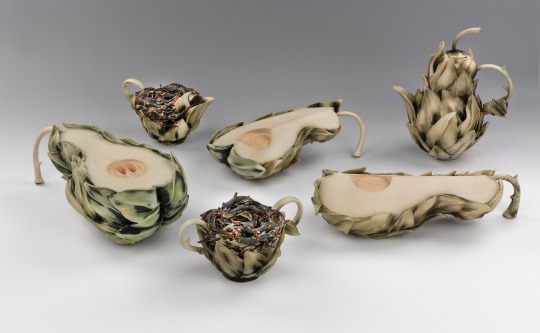
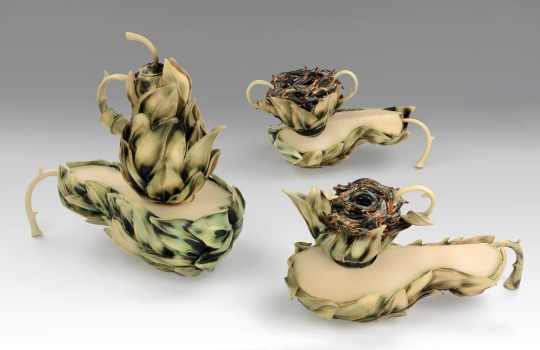
Be Still. . . is a tea set—the pear half and quarters are actually elaborate stands for the teapot, creamer, and sugar bowl. Like many of Kathleen Royster Lamb's pieces, leaves and thorns play a prominent role in the interpretation of the design. To Lamb, the leaves signify a protective layer while the thorns symbolize pain. Lamb considers the pear shape to be a feminine form where the leaves protect the fruit's fleshy, delicate core from the thorns of the creamer and sugar bowl. By exposing the core of the fruit, she wants to create a feeling of vulnerability and drama. Lamb intentionally emphasized the length of each pear's stem in an attempt to represent the balance, or lack thereof, that we find within ourselves. (Susan Peterson, Contemporary Ceramics, 2000)
#bornonthisday Kathleen Royster Lamb enrolled in Portland State University in 1978, but withdrew after her third year because she "wanted an adventure." She relocated to Alaska, where she worked as a commercial fisherman during the summer and traveled all over the world in the winter, visiting New Zealand, Australia, India, and Nepal. Around her thirtieth birthday, Lamb decided to return to college, and this time entered the University of Utah, Salt Lake City, where she received a BFA and MFA in ceramics. She initially majored in graphic design, but soon found herself drawn to clay due to its tactile nature and the technical challenges the material presents. She began teaching ceramics at the college level after graduation, which she continues to do to this day. Lamb has exhibited her works internationally, and her pieces are found in several collections, including the Los Angeles County Museum of Art and the Arizona State Art Museum. ("Do you know: Kathleen Royster, assistant professor of art," This Week @Metro (June 15, 2005)
Kathleen Royster Lamb, Be Still. . ., 1998, stoneware, part A (half pear): 4 1⁄4 x 12 1⁄4 x 6 1⁄4 in. (10.7 x 31.1 x 15.8 cm) part B (quarter pear): 4 x 9 3⁄4 x 6 1⁄8 in. (10.1 x 24.8 x 15.5 cm) part C (quarter pear): 3 1⁄4 x 12 x 5 3⁄4 in. (8.3 x 30.5 x 14.5 cm) part D (sugar bowl): 3 3⁄4 x 6 3⁄4 x 4 in. (9.6 x 17.2 x 10.1 cm) part E (creamer): 3 3⁄4 x 6 7⁄8 x 4 5⁄8 in. (9.5 x 17.6 x 11.9 cm) part F (teapot): 7 1⁄2 x 7 3⁄8 x 4 5⁄8 in. (19.2 x 18.8 x 11.8 cm) part G (lid): 2 1⁄8 x 2 1⁄8 x 1 3⁄8 in. (5.3 x 5.3 x 3.5 cm), Smithsonian American Art Museum, Museum purchase through the Howard Kottler Endowment for Ceramic Art, 2000.3A-G
#KathleenRoysterLamb #tea #craft #teaset
2 notes
·
View notes
Text
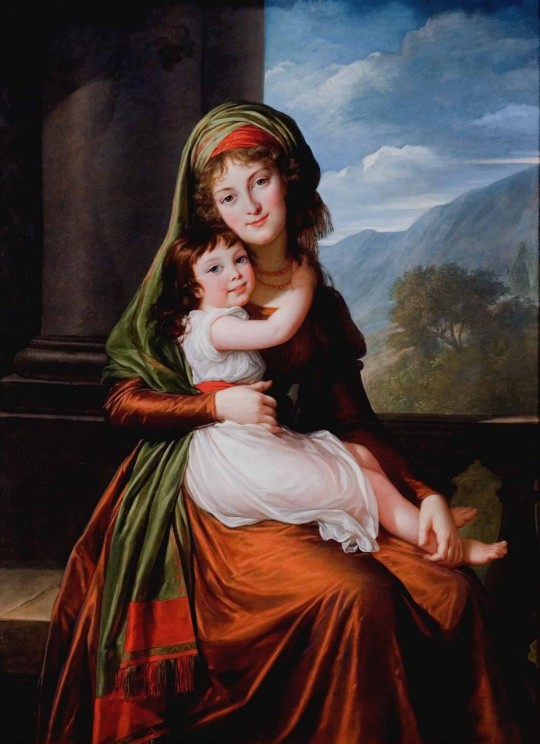
Elisabeth Louise Vigée-LeBrun (French, 1755 - 1842), The Countess von Schönfeld with Her Daughter, 1793, oil on canvas; University of Arizona Museum of Art.
#elisabeth louise vigée le brun#louise elisabeth vigée le brun#women artists#portraits#mothers#children#mother and child
10 notes
·
View notes
Text
vimeo
The first major solo museum presentation of fourth-generation Navajo weaver Melissa Cody (b. 1983, No Water Mesa, Arizona) spans the last decade of her practice, showcasing over 30 weavings and a major new work produced for the exhibition. Using long-established weaving techniques and incorporating new digital technologies, Cody assembles and reimagines popular patterns into sophisticated geometric overlays, incorporating atypical dyes and fibers. Her tapestries carry forward the methods of Navajo Germantown weaving, which developed out of the wool and blankets that were made in Germantown, Pennsylvania and supplied by the US government to the Navajo people during the forced expulsion from their territories in the mid-1800s. During this period, the rationed blankets were taken apart and the yarn was used to make new textiles, a practice of reclamation which became the source of the movement. While acknowledging this history and working on a traditional Navajo loom, Cody’s masterful works exercise experimental palettes and patterns that animate through reinvention, reframing traditions as cycles of evolution. Melissa Cody is a Navajo/Diné textile artist and enrolled member of the Navajo/Diné nation. Cody grew up on a Navajo Reservation in Leupp, Arizona and received a Bachelor’s degree in Studio Arts and Museum Studies from Institute of American Indian Arts, Santa Fe. Her work has been featured in The Barnes Foundation, Philadelphia (2022); Crystal Bridges Museum of American Art, Bentonville, AR (2021); National Gallery of Canada, Ottawa (2019–2020); Museum of Northern Arizona, Flagstaff (2019); SITE Santa Fe (2018–19); Ingham Chapman Gallery, University of New Mexico, Albuquerque (2018); Navajo Nation Museum, Window Rock (2018); and the Museum of Contemporary Native Arts, Institute of American Indian Arts, Santa Fe (2017–18). Cody’s works are in the collections of the Stark Museum of Art, Orange, Texas; the Minneapolis Institute of Arts; and The Autry National Center, Los Angeles. In 2020, she earned the Brandford/Elliott Award for Excellence in Fiber Art.
Webbed Skies is currently on exhibition at MoMA PS1 through September 9nth 2024
6 notes
·
View notes